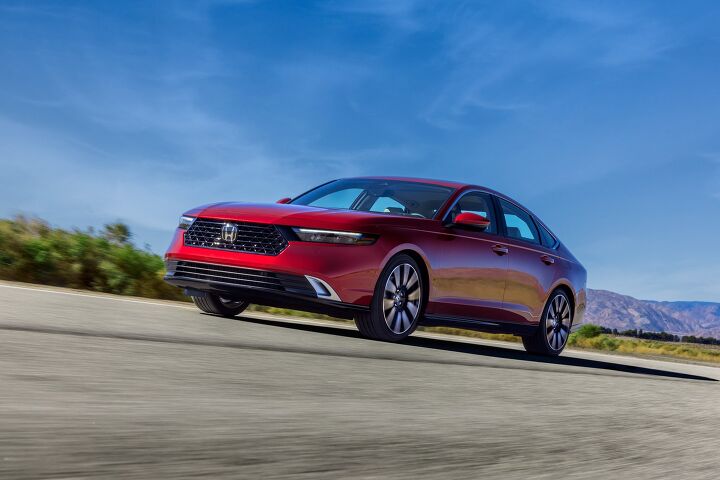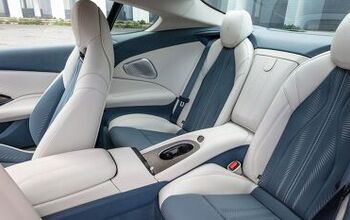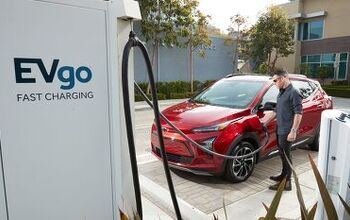Judge Yourself Accordingly: Honda Debuts 2023 Accord

While some brands are running away from the full-size sedan segment as if it were populated with venomous rattlesnakes, others are re-upping their wares on a decently regular basis. The latest? Honda, with its venerable Accord.
Just don’t think it’s going to make as much power as it once did, okay?
That’s because the Big H is breaking trim levels into hybrid and non-hybrid models, with the latter kicking off the range in LX and EX guise. They will continue to utilize the familiar 1.5-liter turbocharged four-banger, good for 192 horsepower and a like amount of torque. The manual transmission was dropped in ’21 and does not make a return for ’23, leaving a CVT as the sole shifting selection.
Other trims (Sport, EX-L, Sport-L, and Touring) will get a hybrid powertrain comprised of a 2.0L four-cylinder gasser and a two-motor hybrid system. No, this doesn’t mean it is all-wheel drive. Combined system output is just 204 horses and torque is 247 lb-ft at a surprisingly high 5,000-8,000 rpm. We’ll wait until driving one to pass final judgment on the suitability of this amount of power but will point out that the departed 2.0L turbocharged mill made 252 ponies and 273 lb-ft of torque at just 1,500 rpm.
Inside, we find a take on the cross-car swath of mesh vents which has taken root as an integral part of Honda design since it showed up on the latest Civic. Ventilation controls seem logically placed and grouped, topped by the typical standing tablet which serves as the interface for infotainment and ancillary controls. Hybrid-powered models (Sport, EX-L, Sport-L, and Touring) get what Honda is describing as their largest-ever touchscreen, checking in at 12.3 inches. Lesser LX and EX trims make do with a 7-inch screen.
Interestingly, there will be a 1-inch finger rest at the bottom of the big touchscreen, a feature that should make it easier to use by providing a stable surface on which to rest one’s hand. For those of us who generally eschew Sirius XM presets and surf channels manually during a long drive, this is a great idea. All hands get a 10.2-inch digital instrument panel but a power flow meter replaces the tachometer in hybrid-electric powered trims. Oh, joy. Rear seat legroom is a notable 40.8 inches and trunk space is listed at 16.7 cubic feet.
Overall length is up 2.8 inches to 195.7 inches and width stands at 73.3 inches. Those of you with accurate memories will recall that, 30 years ago, the new-for-1994 Accord was nearly a foot shorter when it shrank to 184 inches. All new Accords feature a 0.4-inch wider rear track this year, offered with 17- or 19-inch wheels depending on trim.
Honda marked 40 years of Accord production in Ohio this year, and the new Accord will continue to be built in Marysville. Honda says they have produced more than 12.5 million Accords in Ohio since U.S. production began in 1982.
[Image: Honda]
Become a TTAC insider. Get the latest news, features, TTAC takes, and everything else that gets to the truth about cars first by subscribing to our newsletter.

Matthew buys, sells, fixes, & races cars. As a human index of auto & auction knowledge, he is fond of making money and offering loud opinions.
More by Matthew Guy
Latest Car Reviews
Read moreLatest Product Reviews
Read moreRecent Comments
- Dartman If one is so hellbent on drawing attention to themselves just mount a big “Trump 2024” or “Black Lives Matter” flag (your choice) on your truck and call it day. Lot cheaper, same result.
- AZFelix I'd buy a 'harlequin' edition if it was composed of a company's complete palette of greys and silver.Family had a couple of Pontiacs in teal and purple in years past. I was not a fan.My current ride is Lakeside Blue.
- Doc423 Rolling Coal is not a bad thing either.
- Ajla In high school I really wanted a yellow GTO.
- Lou_BC Sweet car.




































Comments
Join the conversation
Honda still can't find its styling. I thought, 2014 was the best iteration. May be due to high car jacking ....
Honda sucks at infotainment, UI and software.